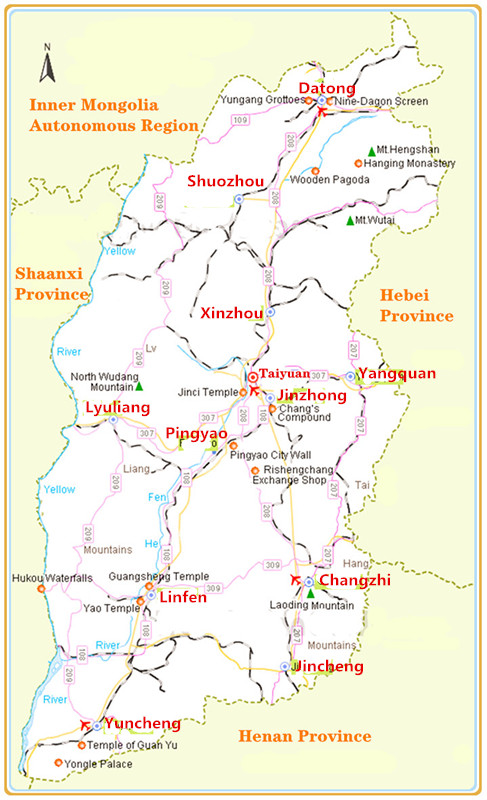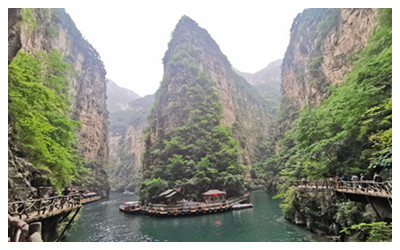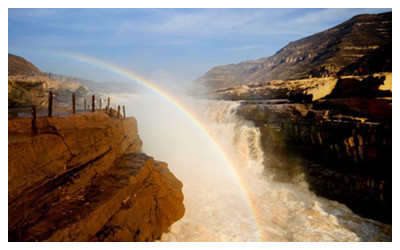Skype: neodalle-travel
Tel: +86 135 7447 2266
E-mail: sales@visitaroundchina.com
 Located in the middle reaches of the Yellow River, Shanxi Province has more than 220 tourist areas and spots. It has basically established the seven largest tourist areas of Taiyuan, Datong, Wutai Mountain, Linfen, Yuncheng, Shangdang and Yangquan. There are also ten tourist scenic areas ranked as the national 4A level scenic areas and more than twenty key scenic areas and spots as the national-level tourist routes and more than sixty scenic areas with unique or monopoly resources all over the country...Detailed Shanxi Map
Located in the middle reaches of the Yellow River, Shanxi Province has more than 220 tourist areas and spots. It has basically established the seven largest tourist areas of Taiyuan, Datong, Wutai Mountain, Linfen, Yuncheng, Shangdang and Yangquan. There are also ten tourist scenic areas ranked as the national 4A level scenic areas and more than twenty key scenic areas and spots as the national-level tourist routes and more than sixty scenic areas with unique or monopoly resources all over the country...Detailed Shanxi MapHistory & Culture
Shanxi is one of the birthplaces of the Chinese civilizations. It was the land of the Jin State during the Spring and Autumn Period. Therefore, it is called Jin for short. The strong state of Qin unified the whole country and established thirty six shires with Shanxi being one among them; the country was resurged during the flourishing period of the Tang Dynasty and the Emperor Minghuang made a good start to the flourishing age of Kaiyuan; during the North Song, the country went downhill and Emperor Huizong promoted Longde to be a prefecture by leading the vassal state of Luzhou; a large number of cultural heritage left by ancient history coupled with complicated topography and landform as well as rivers and mountain forms multitudes of natural landscapes... History of Shanxi
Shanxi is an old revolutionary base. During the World War Two, Chinese Eighth Route Army occupied the Taihang Mountain and established the border region. The revolutionary sites and relics scatter about the whole province. The famous ones include the site of the headquarters of the Chinese Eighth Route Army, Huangyadong arms factory of the Chinese Eighth Route in Licheng and the Memorial Hall of Liu Hulan in Wenshui, etc.
The ancient wall paintings in Shanxi are representative in the development history of Chinese wall paintings. Moreover, drama is also characterized by national style and spirit...Shanxi Culture
Geographical Location
 Shangxi Province is located in the middle reaches of the Yellow River. Loess Plateau starts from the Taihang Mountain in the east to the Wuqiao Range in the west. Its east part belongs to Shanxi Province. Most of the areas in the province are covered by loess. The depth of loess layer ranges from 30 meters to 100 meters. Shanxi Province is in the center of Loess Plateau. It has the Taihang Mountain and the Lvliang Mountain on the east and west sides as well as the Zhongtiao Mountain and the Hengshan Mountain on the south and north sides. The Yellow River flows through the southwest of the province. It covers an area of 156,000 square kilometers...Top Eight Mountains in Shanxi
Shangxi Province is located in the middle reaches of the Yellow River. Loess Plateau starts from the Taihang Mountain in the east to the Wuqiao Range in the west. Its east part belongs to Shanxi Province. Most of the areas in the province are covered by loess. The depth of loess layer ranges from 30 meters to 100 meters. Shanxi Province is in the center of Loess Plateau. It has the Taihang Mountain and the Lvliang Mountain on the east and west sides as well as the Zhongtiao Mountain and the Hengshan Mountain on the south and north sides. The Yellow River flows through the southwest of the province. It covers an area of 156,000 square kilometers...Top Eight Mountains in Shanxi
Population & People
In 2019, the total population of Shanxi Province is 37, 292,220. Shangxi Province has long been a province with many nationalities living together or in scattered communities. At present, apart from the Han nationality, Shanxi Province also has forty five national minorities such as the Hui nationality, Man nationality, Mongolian nationality, Korean nationality and Tibetan nationality. Of them, the population of the Han people account for 99.71% that of the whole province while among the national minorities, the Hui people are mostly distributed in the five cities of Taiyuan, Datong, Yangquan, Changzhi and Jincheng and the districts of Yuncheng, Linfen and Jinzhong.
Economy
Shanxi has abundant mineral resources. It is reputed as the "hometown of coal" in the country. It also boasts rich mineral resources such as iron, aluminum and copper. Its economy is predominated by energy, heavy and chemical industries. It is also relatively developed in industries such as steel, heavy machinery, salt chemical industry and electric power, etc.
Landscapes & Tourism
 The whole province has more than 220 tourist areas and spots. It has basically established the seven largest tourist areas of Taiyuan, Datong, Wutai Mountain, Linfen, Yuncheng, Shangdang and Yangquan. There are also ten tourist scenic areas ranked as the national 4A level scenic areas and more than twenty key scenic areas and spots as the national-level tourist routes and more than sixty scenic areas with unique or monopoly resources all over the country.
The whole province has more than 220 tourist areas and spots. It has basically established the seven largest tourist areas of Taiyuan, Datong, Wutai Mountain, Linfen, Yuncheng, Shangdang and Yangquan. There are also ten tourist scenic areas ranked as the national 4A level scenic areas and more than twenty key scenic areas and spots as the national-level tourist routes and more than sixty scenic areas with unique or monopoly resources all over the country.
Of the abundant human and tourist resources within the borders of Shanxi, the scenic spots and historic sites such as the Wutai Mountain, one of the four largest Buddhist scared places, the ancient northern mountain Hen Mountain, one of the Five Famous Mountains, the Yellow River Hukou Waterfall with majestic vigor, the Xuangkong (Suspending in the Midair) Temple with wonderful article excelling nature, Yingxian wooden tower, Yuncheng Guandi Temple, Taiyuan Jin Ancestral Temple, wall paintings of the Yongle Palace and Yellow River Iron Ox enjoy a great reputation at home and abroad. The well preserved ancient Pingyao City and Yungang Grottoes, one of the three largest grottoes in the country, are listed into the World Cultural Heritage Records. The grand courtyard houses of Jin merchants in Central Shanxi with unique characteristics are reputed as the "bright pearl of residence houses in the north during the Ming and Qing Dynasties"...Shanxi Attractions, Shanxi Tourism Map
Landscapes : With the Taihang Mountain to the left and Lvliang Mountain to the right, Shanxi has a large number of cultural relics and temples. Moreover, there are also the two largest natural landscapes, namely, Wutai Mountain, a famous Buddhist mountain and Hen Mountain, one of the Five Famous Mountains.
Ancient Traditional Dwellings in Shanxi
Top ten Buddhist temples in Shanxi
Top ten attractions in Shanxi
The Great Wall in Shanxi
 Ask Questions ?
Ask Questions ?